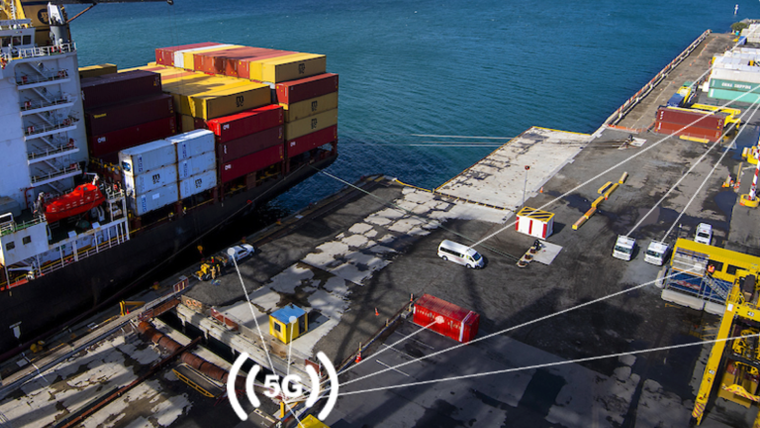
Wellington's CentrePort has partnered with Tū Ātea, a Māori-run communications provider to build a private 5G network for the port operator.
Such a network is, as the name implies, a communications systems limited for use by private entities in particular areas only. The benefit of it is operators can configure it for specific use cases, and avoid congestion on public and Wi-Fi networks.
Private networks can use the older 4G/LTE technology, or the newer, better-performing and technically different 5G variant which is what Tũ Ātea will supply for CentrePort.
CentrePort's network is scheduled to go live in the third quarter of this year. It will initially provide high-speed connections to dozens of tablets in vehicles and cranes, to help manage and process some four million tonnes of freight annually, Tũ Ātea said.
The 5G high-power radio transceivers and antennas will be mounted on CentrePort's light poles, and connect via a fibre network to Tũ Ātea's 4G and 5G capable Converged Packet Core, a cloud-based system to manage different communications technologies.
Antony Royal, the chief executive of Tũ Ātea, said the use of the Converged Packet Core means the company can provide 5G network slicing for CentrePort.
In simple terms, 5G network slicing lets operators set up multiple virtual networks, tailored for the specific requirements of different applications such as low-latency, ultra-reliable connections, or Internet of Things low-bandwidth use cases. This can be done on the same physical 5G network.
CentrePort's chief executive Anthony Delaney said the port is a dynamic environment in which reliable and fast communication is vital to the safety of staff and overall efficiency of operations.
“Coverage can be tricky due to large ships and container stacks blocking radio signals. This Private 5G network will be optimised to overcome that and will underpin converged smart network features we are planning," Delaney said.
Texas-based Mavenir, which has built private networks in Australia with telco vendor Nokia, is Tū Ātea's technology partner for the project.
Slow progress on private wireless networks in Aotearoa
Compared to Australia, private cellular networks have been slow to take off in New Zealand. Christchurch City Council operates a private 4G/LTE network, along with Wellington International Airport.
A September 2023 market study by the Australian Communications and Media Authority (ACMA), which allocates radio-frequency spectrum usage licenses across the Tasman, found the mining and resource sector alone had over 50 private 4G and 5G networks, with more coming up.
The railway, agriculture, entertainment, advanced manufacturing, and infrastructure sectors are also looking at private 4G/5G networks, ACMA found.
ACMA has been active in the development of private 4G/5G networks. As part of that, the authority made it possible to apply for area-wide licenses (AWLs) in the 3.4 to 4 GHz spectrum bands, which are suitable for 5G private networks. Businesses have also been able to apply for 26 GHz millimetre wave spectrum, in which the signals have short reach but are able to carry large amounts of information.
In New Zealand, the government, faced with serious disruption from the COVID-19 pandemic, decided to forego the scheduled 5G spectrum. Instead, it opted for a direct allocation of spectrum, with Spark, Vodafone/One NZ and 2Degrees each receiving 80 MHz. The Interim Māori Spectrum Commission which is now Tū Ātea, received 100 MHz of spectrum.
There could be room to grow the wireless private network business in New Zealand despite the direct allocations of spectrum, however.
Consultant and radio engineer Jonathan Brewer explained the Ministry of Business, Innovation & Employment's Radio Spectrum Management (RSM) office has withheld 160 MHz of spectrum in the n78 or C-band which is between 3.3 and 3.8 GHz, and used for 5G New Radio (NR) transmissions.
Of that, 40 MHz has been put into use by wireless internet providers for regional broadband. Meanwhile, 120 MHz is retained by the Crown, and that spectrum could be used for private networks.
16 Comments
The power companies in the hauraki area have put in their own Fibre network, solely for substation communication.
That sounds like the typically inefficient thing a regulated monopoly would do....
Who owns CentrePort? Is CentrePort taking direction from their owners/masters in the selection and evaluation of a preferred supplier/contractor?
Surely they will have got three quotes?
Not if it's a DEI initiative.
Of course it was an open tender. But the contract requirement for 20% of the workforce to speak Te Reo would have ruled out any other company from submitting a tender response. Thus signing a contract for double or triple the normal commercial rate can be justified on the basis that it was the only compliant tender response received. See how this works?
K.W. could you please link to where this is listed as a tender requirement? I've had a search around and can't find that anywhere. Thanks
I was being sarcastic. Knowing the Wellington Council, it probably wasnt even tendered at all but just handed off to their one of their family members Mahuta-style.
And a quick check of the tender registry shows that to be accurate, as correct, you can't find it anywhere.
If your referring to the usual" if a maori business is involved it must be a have" , you might want to reread the bit where they were allocated the spectrum.
Noted. They must have put in a claim on radio waves as part of their taonga and allocated part of the frequency spectrum. Not sure if this is the correct Maori term. Maori Spectrum Commission. Wonder how that's divided amongst the tribes or is it put into a special govt budget area allocated to Maoris.
I'm starting to see the need for the Treaty Principles Bill which may get rid of these nonsensical claims.
Maori got the spectrum at no cost. Yes, thats right, completely free. Whereas Spark and One and everyone else had to pay tens of millions of dollars for their allocation. So if you are ever wondering why foreign companies dont really want to come invest in NZ to compete with existing providers, that's a good example.
Also if you are wondering why the Spark services you pay for are so expensive, and the Spark share price is in the toilet. Its not a level playing field when some people get stuff for free, and everyone else has to subsidise the cost of it.
If you look at the announcement linked to, the spectrum was directly allocated to Spark, Vodafone/One NZ, 2degrees and Tū Ātea. The govt forewent the usual spectrum auction for 3.5 GHz management rights. Spark's current performance isn't due to it being allocated 5G spectrum, and it seems that Tū Ātea is putting its holdings to good, commercial use, in an underserved niche of the market. Good for them.
The issue is not whether it was directly allocated or auctioned. Its that Spark and others had to pay, while the Tu Atea got it for free (see the bottom of the announcement that you linked to - it helps to read right to the end).
How does a company like Spark compete with a company like Tu Atea when they are burdened with a $24m cost that their competitor doesnt have to bear?
Putting free stuff to commercial use is a great business model. Wish we could all do that and not just a select few.
In return for the allocated spectrum, Spark, One New Zealand and 2Degrees will each pay the government $24 million between 2023 and 2025. This funding will be used to pay the Rural Connectivity Group to expand mobile coverage into areas of rural New Zealand which would not otherwise have been provided with coverage commercially (for example, rural areas where there are mobile black spots). This funding is additional to the value of the works required to provide 5G to towns.
Clearly the three thought that was a decent deal, as it gets them access to more customers in difficult to reach areas, and enables them to recover the investment. Tů Ātea does not have that option and as it happens, the RCG is a joint venture between Spark, One NZ and 2degrees. It seems "burdened" isn't the right word here. If you apply the usual measure for spectrum rights leases, dollars per MHz and population, I think the telcos got a fairly sweet deal, particularly when they can recover the money.
Now let's look at the 4G spectrum auction in 2013, for 700 MHz spectrum: Telecom and Vodafone paid $66 million each. 2degrees, $44 million. There was GST payable on top of that. Might be helpful context.
When one commercial operator gets free stuff and the others dont, its not a level playing field. Its an unfair advantage. And in a normal country this kind of thing would be unlawful.
And dont forget the fact that as a Maori entity it doesnt have to pay company income tax either.
Spark et al paid because they had no choice. Kind of helps when the Govt has you over a barrel with no alternative means of acquiring spectrum. What are they going to do, turn off their mobile networks, shrug and walk away? Hand everything over to Starlink?
Maori businesses should have to pay the same amount as non-Maori businesses. Because that would be fair and would promote genuine competition.
Now replicate this free stuff model throughout the rest of NZ industry, and you quickly see why nobody is lining up to invest. Why would you?
Tū Ātea Limited appears to be a commercial company, registered in New Zealand. Are you saying it's not subject to income tax, like Sanitarium?
One could look at the $24 million payable over three years for a fat, 80 MHz chunk of valuable spectrum as a sweet deal, particularly since that investment went into a joint commercial venture that's owned by the telcos. A deal that it would be silly to refuse, because it's really good and gets you lots of bandwidth for very little, and paying customers in rural areas who are now pleased they have mobile and fixed wireless broadband coverage. The RCG gets government funding. Maybe that free stuff isn't fair?
You'll also find that in the vast majority of nations on Earth, there is no "alternative way of acquiring spectrum". You buy licenses, usually in auctions, from the government. There are very good reasons for why that is so. It can be very very expensive to buy RF spectrum management rights, as per the link I provided to the 4G 700 MHz auction in NZ.
Or you can just ignore all of the above, detail like Starlink not actually being available in New Zealand until 2021 and then only in a very limited capacity. Or the fact that Starlink still can't provide anything like full mobile service coverage for New Zealand, and never will be, for really obvious reasons. Etc.

We welcome your comments below. If you are not already registered, please register to comment
Remember we welcome robust, respectful and insightful debate. We don't welcome abusive or defamatory comments and will de-register those repeatedly making such comments. Our current comment policy is here.